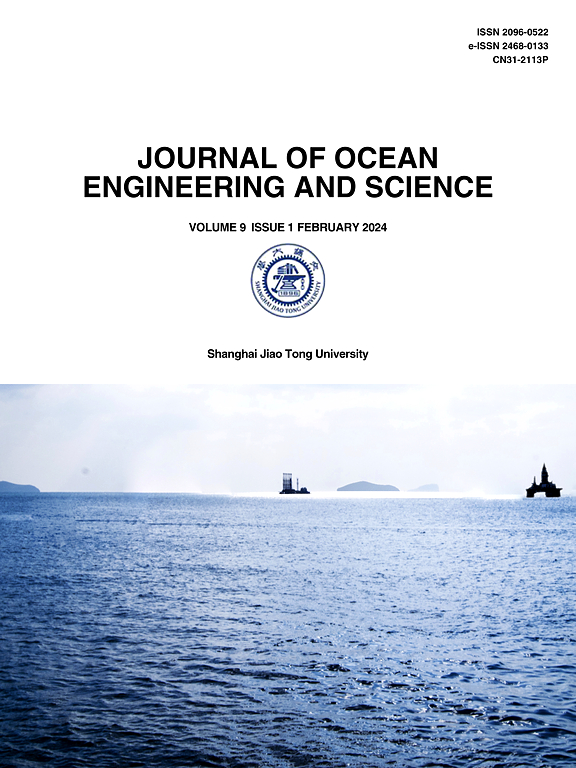浮动风力水产养殖平台在风、波浪和水流共同作用下的动态响应研究
IF 11.8
1区 工程技术
Q1 ENGINEERING, MARINE
引用次数: 0
摘要
浮式风力养殖平台由于具有充分开发和利用海洋空间及其资源的潜力,越来越受到学术界和工程界的关注。然而,这些平台整合了浮动风力涡轮机和水产养殖网箱的流体动力学和空气动力学,使其机械性能更加复杂。本研究旨在评估三种不同的水动力和气动阻尼分量对浮式风养殖平台动力响应的影响以及随机环境荷载对平台动力响应的贡献。建立了一种液压-气动-伺服耦合方法。首先对静水中平台进行了衰减和强迫振动试验,然后模拟了不同环境荷载组合下的动力行为,包括叶片的脉动风荷载、浮体的随机波浪激励力和养殖网箱系统的粘性力。风力机的气动阻尼和浮体的水动力阻尼分别在低频和波频范围内占主导地位。环境荷载分量中,低频范围内浪涌方向上二阶波浪力和湍流风荷载占主导地位。平台在波频范围内的动力响应主要由一阶波浪力引起。渔网可以抑制低频运动,但对波频运动几乎没有影响。本文章由计算机程序翻译,如有差异,请以英文原文为准。
Investigation of the dynamic response of a floating wind-aquaculture platform under the combined actions of wind, waves and current
Floating wind-aquaculture platforms are drawing increasing attention from the academic and engineering communities due to their potential to fully exploit and utilize marine space and its resources. However, these platforms integrate both the hydrodynamics and aerodynamics of floating wind turbines and aquaculture cages, making their mechanical properties more complex. This study aims to evaluate the effects of three different hydrodynamic and aerodynamic damping components on and the contribution of the stochastic environmental loads to the dynamic response of a floating wind-aquaculture platform. A coupled hydro-aero-servo method is established. Decay and forced oscillation tests of the platform in still water are firstly numerically performed, followed by simulation of the dynamic behavior under different combinations of environmental loads, including the fluctuating wind load of the blades, stochastic wave excitation forces on the floating body and viscous force of the aquaculture cage system. The aerodynamic damping of the wind turbine and the hydrodynamic damping of the floating body are dominant in low- and wave-frequency range, respectively. Regarding the environmental load components, the second-order wave force and the turbulent wind load are dominant in the surge direction in the low-frequency range. The dynamic response of the platform in the wave-frequency range is mainly induced by the first-order wave force. Fish nets can suppress the low-frequency motion but have almost no influence on the wave-frequency motion.
求助全文
通过发布文献求助,成功后即可免费获取论文全文。
去求助
来源期刊

Journal of Ocean Engineering and Science
Multiple-
CiteScore
11.50
自引率
19.70%
发文量
224
审稿时长
29 days
期刊介绍:
The Journal of Ocean Engineering and Science (JOES) serves as a platform for disseminating original research and advancements in the realm of ocean engineering and science.
JOES encourages the submission of papers covering various aspects of ocean engineering and science.
 求助内容:
求助内容: 应助结果提醒方式:
应助结果提醒方式:


